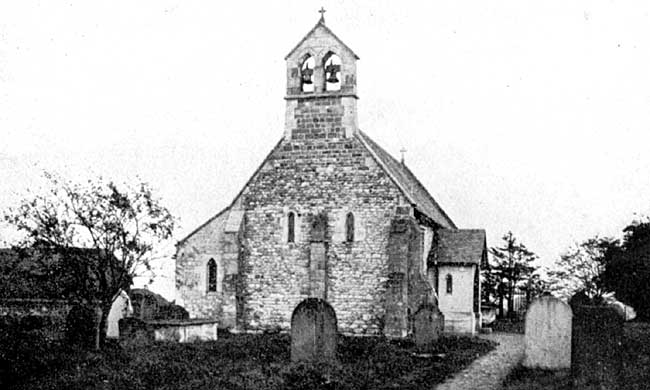< Previous
Austerfield font.
By Rev. A. E. Meredith

Austerfield church, c.1915 (image courtesy of www.fromoldbooks.org).
I have been told that a few notes of the Austerfield Font, and its rather singular story, will be of interest to the members of the Thoroton Society.
It will be remembered that on the occasion of a visit to Scrooby, some years ago, (July 1905), it was noted with surprise that the ancient font, in which it is supposed that William Brewster was baptized, had been carried off from Scrooby Church to find a home in America. If the members of the Society had visited Austerfield, they might have seen in the old Norman church the ancient font in which Brewster's young disciple William Bradford was baptized, and many a generation of children both before him and since. This font has so far escaped a journey to America; but it has passed through a period of desecration and degradation quite as bad, and yet has happily survived. There is nothing remarkable about it to distinguish it from other ancient fonts—and it may be of Norman date,—it is constructed of plain rough stone, quite circular in shape and without any carving or ornamentation. Its circumference is 7ft. 5m (outside measurement), the interior diameter is 2ft. 3m., and its depth 7in. A portion of stone has been broken off probably by the forcible removal of the font cover and its hinges, while small holes on the surface of the bowl seem to show that staples for fastening the cover have also been removed. It stands on a new stone pedestal which was made for it at the last restoration of the church in 1898.
For more than sixty years before that date it was certainly not used as a font, and for about half that period it was put to far baser uses. For some unexplained reason when certain alterations or improvements were made in the church in 1834, or perhaps a few years later the font was removed from the building and given to the Clerk, Mr. John Milner, who had a small farmstead in the village. Strange things were done in those days, but it is almost inconceivable that either Vicar or Wardens could regard the font as "a thing of naught; but apparently, Milner was allowed to take it and he used it for a pump trough. In 1851 the Rev. R. Hines, Curate of the parish, now Vicar of Shepreth in the diocese of Ely, saw the trough in Milner's yard and, having heard its story, made an attempt to get it restored to the church. He was unsuccessful, and for ten years longer it occupied its humble position till the Rev. B. Oliver, Curate of the newly formed parish of Bawtry-with-Austerfield, found means to recover it, and provided another trough for Milner's pump. The font was thus restored to the church, but not to its sacred use, and it lay on the floor of the church as a neglected relic, till in 1898 it was fully restored to its proper use.
The story so far is probably not unlike other similar stories of the use and abuse of ancient fonts; but it receives additional interest from the fact that there is in a chapel at Lound, near Retford, another stone for which the claim has been made that it is the original font belonging to Austerfield Church, and consequently the one in which William Bradford was baptized. Whether this so called font was ever in Austerfield Church or not (and the evidence on this point is indecisive), it stood for some years in the garden of a farm in Austerfield Parish and was popularly known as "Bradford's Font," and was actually named in a valuation award as "Baptismal Font."
A story of its removal from Austerfield Church obtained such wide credence that a few years ago it was said that 1,000 dollars had been offered for it by the Church across the Atlantic. And if in the end it has escaped the fate which befell the Scrooby Font, it is no doubt owing to the fact that a little examination shews that it is probably no font at all but a quern or mortar, used in old days for grinding corn in; it seems too small to be an ancient font, and moreover it has four projecting ears which were usual in querns, and it bears no signs of having been broken by the removal of the cover, nor any holes to be seen where the staples of a pre-reformation cover would have been fixed. It has thus little claim to be "Bradford's Font," and our American friends may be well content with what they have got from Scrooby, for it may be safely said that it is the only font, from this early home of the Pilgrim Fathers, which is ever likely to reach their shores.

< Previous
